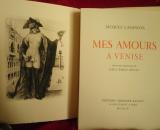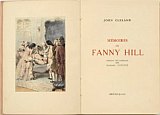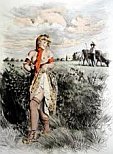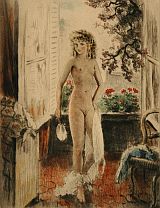Every enthusiastic print collector tries to make a determination on what can be considered an “original print” by examining the technique used to create a print coupled with the artist’s preferred media. An original print is a work conceived and originated by the artist as a print and excludes reproductions of the work conducted in another medium. In other words, if you are a serious collector of Andy Warhol’s art, you better own some screen-prints or silkscreens. But if you are a collector of Paul Emile-Becat, chances are that you own some rare books containing intaglio dry-point etchings.
No other artist has produced such an amazing collection of books containing erotic art than Paul-Emile Becat (1885-1960). He was an accomplished printmaker in addition to being an extremely prolific painter. He is best known for his portraits of French writers, and for his erotic works that exhibit African or Eastern influence. He used the drypoint printmaking technique that employed intaglio printing plates made from sheet metal such as copper. Using a hard, pointy needle, he designed his images on the surface of the sheet metal by incising raised edges and depressions. Colors were rubbed to the design that eventually got transferred on to paper when the paper was pressed against the plate. To create darker prints, he would simply incise a deeper design that tended to hold more ink.
Becat specialized and mastered this technique quite late in his career after his return from his travels to the Congo, Gabon, and the Sudan regions in 1933. Over 90 books illustrated with such images, each having a limited number of copies, have been released since then. They all demonstrate Becat’s characteristic gentle feel with lines that are crisp and controlled and finer than a hard pencil drawing, accompanied by pastel shades. Current pricing varies by the importance as well as the scarcity of the publication, and as is the case with any rare book, each individual copy’s price is affected by individual attributes, such as condition. We have included a few examples of the rarest works that are currently circulating the marketplace.
 Mes Amours A Venise.
Mes Amours A Venise.
Jacques Casanova [Giovanni Giacomo Casanova]. Paris: G Raoult, 1954.
Decorated with 20 original drypoints and limited to 390 copies. Average price €1000.
 Mémoires de Fanny Hill.
Mémoires de Fanny Hill.
Traduit de L’Anglais par Isidore Liseux. Cleland, John. Bruxelles: SL. Deux, circa 1948.
Translated from the English in a total edition of 550copies, contains 10 drypoints in two volumes. Average price €700.
L’ingénue libertine. Colette, Sidonie Gabrielle. Paris: Georges Guillot, 1947.
Book contains 20 original drypoints in a total distribution of 420 on Arches paper. Average price €600.
These are some of the most collectible and highly priced books of Becat drawings available. Fortunately for Becat fans that are not ready to spend one thousand Euro for a book or two, there is still a large number of rare books that do contain original prints and average €200. Unlike a great many other styles of art such as the contemporary-art scene, Becat’s work is not suffering the consequences of commoditization. Collectors are not buying his drypoints because prices have climbed and they are looking to score on a good asset investment opportunity. On the contrary, Becat’s collectors are buying his work because they like erotic art and they admire his style. They are in fact, looking at the work of art for its beauty, instead of merely treating it as a commodity. All that means is that any price appreciation is for the long-run, and it is not going to fall victim to any kind of bubble that could get popped in the near future.


{ 0 comments… add one now }